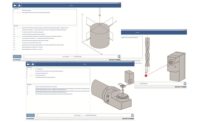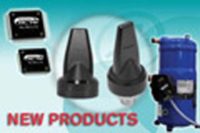Marposs Corp. has expanded its MIDA VTS visual tool setter family with the addition of the VTS WF45 and WF85 wide field versions suited for non-contact measuring and verifying “double-sided”, larger diameter tools. Relying upon LED technology, the wide field versions can perform both profile and surface integrity inspection of the entire tool front to back, identifying any minor faults in the work tool that could affect workpiece integrity. Typical applications include CNC machines, especially milling machines where tools are heavily subjected to wear and dimensions need to be continually checked.
These new wide field versions can process tools with diameters from 40 microns up to 40 mm, or 2.9 mm diameter for double sided measurements, while achieving resolution of 0.4 microns and repeatability of 0.8 microns. The VTS wide field versions perform measurements on tool diameters of up to 5 mm in just one positioning cycle. For example, they can measure the tool length, static or dynamic tool diameter, cutting edge TIR, as well as compensating for machine axis thermal drift.
Additionally, the tool setters come with new software that simplifies the process of the measuring cycle and stores the information of the tool so that tool integrity can be checked in seconds. Whereas software used in a typical measuring cycle with a common tool of less than 3mm may take about 30 seconds, a larger tool could take up to two minutes. With the VTS WF45 and WF85 software, the true diameter can be obtained significantly faster.
The basic principle of the VTS system is the measurement of a variety of tool dimensions -- such as tool length, tool diameter, tool run-out and cutter-radius -- through the processing of images taken by a CCD (charged coupled device) camera. The units are installed inside the machine working area to monitor actual tool working conditions without any contact while the tool is rotating at full spindle speed (up to 80k rpm). This ability thereby reduces pre-setting time, improving accuracy and eliminating any collision hazards.
Pneumatic shutters cover and protect the optical lens when VTS is not working. Furthermore, an air flow from the optical window forms an air barrier that rejects chips and coolant drops, keeping shutter side clean and protecting the optical lens when the shutter is open.
The VTS family of tool setters can be also used to manually analyze tool surfaces, thanks to a continuous frontal light: the operator can see on a PC monitor the illuminated tool surface and evaluate cutter integrity.
Marposs Corp.
(248) 370-0404








